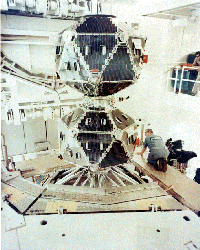
The Vela-5A nuclear test detection satellite was part
of a program run jointly by the Advanced Research Projects of the U.S.
Department of Defense and the U.S. Atomic Energy Commission, managed by the
U.S. Air Force. It and its twin, Vela-5B, were placed ~180 degrees apart in
nearly circular orbits at a geocentric distance of ~118,000 km on 23 May 1969.
The orbital period was ~112 hours. The satellite rotated about its spin axis
with a ~64-sec period. The X-ray detector was located ~90 degrees from the spin
axis, and so covered the celestial sphere twice per satellite orbit. Data were
telemetered in 1-sec count accumulations. The X-ray detectors on Vela 5A failed
on 24 July 1970.
The scintillation X-ray detector (XC) aboard Vela 5A consisted of two 1-mm-
thick NaI(Tl) crystals mounted on photomultiplier tubes and covered by a
5-mil-thick beryllium window. Electronic thresholds provided two energy
channels, 3-12 keV and 6-12 keV. In front of each crystal was a slat
collimator providing a FWHM aperture of ~6.1x6.1 degrees. The effective
detector area was ~26 cm
2. Sensitivity to celestial sources was
severely limited by the high intrinsic detector background.
Both Vela 5A and 5B also carried 6 gamma-ray detectors. They had a total
volume of ~60 cm3 of CsI and could detect photons in the 150-750 keV
energy range. It was in 1969-70 that the Vela spacecraft first discovered
gamma-ray bursts. The gamma-ray detectors continued to function until at least
1979.
The four Vela satellites (5A & B, 6A & B) recorded 73 gamma-ray
bursts in the ten year interval July 1969 - April 1979.